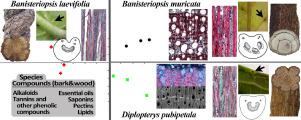Flora ( IF 1.9 ) Pub Date : 2020-12-24 , DOI: 10.1016/j.flora.2020.151760 Nívea Nagamine-Pinheiro , Christopher W. Fagg , Sueli M. Gomes , Regina C. Oliveira , Júlia Sonsin-Oliveira

|
Ayahuasca is a traditional psychoactive beverage with pharmaceutical potential, prepared with Banisteriopsis caapi and Psychotria viridis, although the use of non-traditional plants - the so-called “Ayahuasca analogues” -, such as Banisteriopsis and related species, are also reported. These species are highly polymorphic and inconsistent in flowering periods, being difficult to identify when collecting to prepare the brew. To aid their separation in a vegetative state, some species used in Ayahuasca analogues (B. laevifolia, B. muricata and Diplopterys pubipetala) were characterized in their wood, outer bark and leaf morphoanatomy. We also verified whether their use is supported by histochemical data and investigated other compounds of pharmaceutical importance, in comparison with B. caapi. Usual techniques and methodology were used for histochemical and histological investigations, in addition to X-ray imaging for examining crystal organization and venation patterns. The wood anatomy descriptions of these species are given for the first time, and new characters were described, such as the tangential alignment of prismatic crystals in ray cells of D. pubipetala. Vegetative characters aid the species identification when reproductive material is unavailable, as the species differed in outer bark morphology, leaf morphology and anatomy and wood anatomy. Statistical analyses based on qualitative and quantitative anatomical features reinforce the recent distinction of Banisteriopsis and Diplopterys genera. Histochemical analyses revealed the presence of important compounds of potential pharmacological use: alkaloids, saponins, essential oils, lipids, pectin, tannins and general phenolic compounds, mostly in parenchymatous tissues in the bark and lesser in the wood. Alkaloids found mainly in the bark support the use of these plants in Ayahuasca analogues, although further studies are needed to ensure its safety and to exploit their pharmacological potential. It also raises an alternative extraction technique that could use solely strips of bark for small preparations of Ayahuasca, allowing for sustainable plant management.
中文翻译:

亚马逊精神饮料Ayahuasca类似物中使用的三种Malpighiaceae植物的营养解剖学,形态学和组织化学
Ayahuasca是一种具有药物潜力的传统精神活性饮料,由Banisteriopsis caapi和Psychotria viridis制备而成,尽管也有报道称使用了非传统植物,即所谓的“ Ayahuasca类似物”,例如Banisteriopsis和相关物种。这些物种高度多态,在开花期不一致,在收集以准备啤酒时很难辨认。为了促进它们在营养状态下的分离,某些Ayahuasca类似物(B. laevifolia,B。muricata和Diplopterys pubipetala)中使用的物种)的特点是木材,外树皮和叶片的形态解剖学。我们还验证了它们的使用是否得到了组织化学数据的支持,并与ca. Bapi进行了比较,研究了其他具有重要药学意义的化合物。除X射线成像外,还使用常规技术和方法对组织化学和组织学进行研究,以检查晶体的组织和静脉纹。首次给出了这些物种的木材解剖学描述,并描述了新的特征,例如,朱顶兰射线细胞中棱柱形晶体的切向对准。。当生殖材料不可用时,营养特征有助于物种鉴定,因为该物种的外皮形态,叶片形态,解剖结构和木材解剖结构不同。基于定性和定量解剖特征的统计分析加强了近鞭毛虫和双翅目的区别属。组织化学分析表明存在潜在的潜在药理作用的重要化合物:生物碱,皂苷,香精油,脂质,果胶,单宁和一般酚类化合物,主要存在于树皮的薄壁组织中,而在木材中较少。主要在树皮中发现的生物碱支持在Ayahuasca类似物中使用这些植物,尽管需要进一步研究以确保其安全性并开发其药理潜力。它还提出了另一种提取技术,该技术可以仅将树皮条用于小规格的ya树花,从而实现可持续的植物管理。



























 京公网安备 11010802027423号
京公网安备 11010802027423号